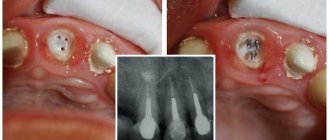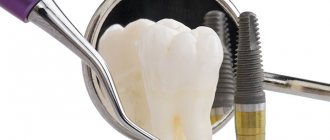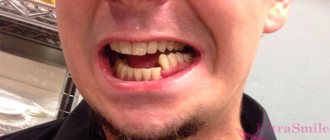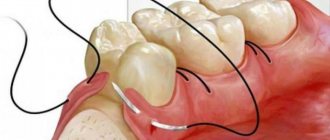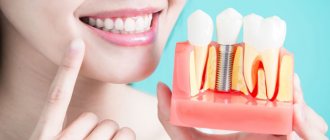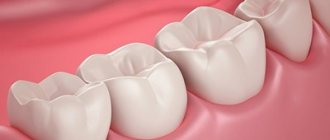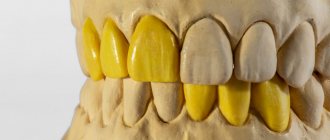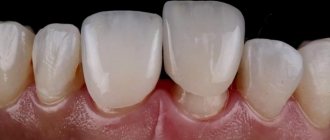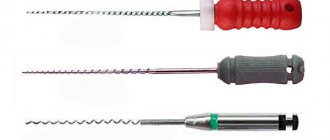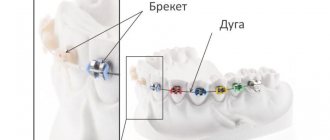From this article you will learn:
- types of fixed dentures on 4 implants,
- their cost, pros and cons,
- reviews on All-on-4 prosthetics.
The article was written by a practicing implantologist.
Dental prosthetics on 4 implants is an implantation technique that is used in the complete absence of teeth on the jaw and involves the installation of a permanent bridge prosthesis within the first 3 days after surgery. This technique was developed by the Swiss implant manufacturer Nobel-Biocare in 1998, and it is called All-on-4 (translated as “All on 4 implants”).
The surgical operation of installing 4 dental implants into the bone usually takes from 35 minutes to 1 hour, and then the prosthetic stage begins. The peculiarity of this technique is that at first your fixed prosthesis on 4 implants can only be temporary (i.e. adaptive). You will be able to use such a permanent prosthesis either for up to 5 months or for 2-3 years, which will depend on the design of the temporary prosthesis you choose and its cost. After this period, your temporary fixed prosthesis must be replaced with a permanent one.
Fixed denture on 4 implants –
As we said above, permanent All-on-4 prosthetics is carried out only in the second stage. If the patient has chosen an inexpensive option for a fixed temporary prosthesis (without a metal frame), permanent dental prosthetics All-on-4 is carried out after 5 months. If the temporary prosthesis was made on a metal frame, which greatly increases the cost of All-on-4, then re-prosthesis is carried out on average only after 2 years (maximum 3 years).
In this article we will talk about the features of temporary and permanent fixed dentures on 4 implants, and we will try to describe in simple words their differences from each other. You should also know that the cost of a temporary prosthesis will be included immediately in the price of All-on-4, but you will have to pay extra for a permanent prosthesis. The cost of dental prosthetics on 4 implants at the second stage will range from 150,000 to 550,000 rubles (depending on the type of permanent prosthesis).
All-on-4 prosthetic implantation scheme:
Is all-on-4 implantation really not for everyone?
The fact that this solution is not suitable for everyone is only partly true: the all-on-4 protocol is used for resorption (resorption) or atrophy of mild or moderate bone tissue. That is, if the jawbone is severely atrophied, then four implants will actually not be enough.
There are many issues associated with this limitation: in particular, there are clinics that implement only the all-on-4 protocol and do not offer the patient alternatives, which means the solution is doomed to failure immediately. If there is little bone tissue or its quality is low (loose bone) or if there is acute inflammation of periodontal tissue, then the implant solution should be different. And the doctor must understand this if he wants his patient’s restored teeth to last as long as possible.
For example, adding NobelZygoma zygomatic implants to the upper jaw, or the all-on-6 protocol (the number of supports increases and with more pronounced atrophy the system will be more reliable). It is worth noting that sometimes six implants are not enough: in case of extreme resorption or inflammation, basal implantation is the best solution.
Indications for tooth restoration on four implants
That is, a personalized approach and thorough 3D diagnostics are important, which will allow you to assess the condition of tissues in volume from all sides and choose a truly suitable, individual solution.
Advice! Be sure to undergo 3D computer diagnostics before dental implantation. And visit several clinics - compare the proposed options, evaluate the doctors’ arguments in favor of one or another solution.
MYTH
The use of a clearly dictated All-on-4 protocol limits the possibilities - it is impossible to select places in the jaw bone tissue with the most suitable bone tissue in size and density.
IS IT TRUE
Those who say this have absolutely no understanding of what protocol is and certainly do not follow it. The All-on-4 protocol is a set of rules and methods combined into a sequence of actions for effective dental restoration in various clinical cases. And an integral part of its execution is 3D modeling of a specific clinical case to plan the placement of implants, taking into account the quality of the patient’s bone and the parameters of the formed bite. All this allows you to avoid mistakes and risks.
A complete denture will not adhere well to the implants and some of them will be overloaded, is that true?
With the exception of the situations that we described above, four implants are quite enough to support a full-fledged denture of 10-12 crowns per row. Implants in the lateral zone are installed at an angle, thus using a larger area of the jaw bone.
In addition, the prosthesis has a metal frame (except for cases where the adaptive prosthesis is frameless and is placed on the day of the implantation surgery, that is, according to the “teeth in 1 day” protocol). The frame reliably connects and stabilizes the implants. There can be no rebound effect - due to the presence of a strong base inside the prosthesis, as well as planning the process of placing implants taking into account future prosthetics. In addition, we do not chew with only one extreme tooth - all side elements are used for this: the load is distributed evenly.
An example of creating a real frame for all-on-4 prosthetics and a model of two complete dentures with 12 crowns for each row
At the preparation stage, at least two doctors are involved in the process - an implant surgeon and an orthopedic dentist, who work closely together. And if the prosthesis is uncomfortable, does not normalize the bite, dangles, and so on, then this means that the surgeon and the orthopedist did not coordinate their actions, the prosthesis was not worked out before the start of treatment, and the implants were placed without further understanding of how the prosthesis would be attached to them .
Thanks to the NobelClinician software, which is used to plan all stages of all-on-4 implantation using the Nobel Biocare brand, the doctor analyzes the quality and quantity of bone in volume, selects the placement points of the implants, the dimensions of the structures, and their exact angle of inclination. Next, the entire “implant-prosthesis” structure is modeled, and multi-unit abutments with the appropriate angle on which the prosthesis will be attached are selected. Then it is calculated how the chewing load will be distributed: the bite parameters are taken, standard load parameters are entered into the program, and then the chewing process is simulated. Thus, the possibility of excessive load on the prosthesis and its breakage is completely eliminated.
We guarantee high results! We use only original implants and prosthetics for them. We do not skimp on your health and achieve lasting treatment results that will last for many years.
Free consultation
What implants and prostheses are used?
The “all on 4 implants” prosthetic technology was developed and introduced into global dental practice by the American company Nobel Biocare. Since then, the components of this brand have been considered the standard of quality. However, over the twenty-year period of use of the technique, many worthy analogues have appeared, produced by domestic and foreign enterprises.
Implants
The YuliSTOM dental clinic in St. Petersburg offers a wide range of titanium pins and abutments from different manufacturers for installation. The patient can choose the most suitable option in terms of quality and cost from the following brands:
- Rusimplant are universal orthopedic elements of the ConeFit system, produced in Russia using German technologies. Made of Grade 5 (titanium) alloy, corrosion resistant, highly compatible with biological tissues, lightweight and durable.
- Superline is a Korean middle-class prosthetic system made of Grade 4 alloy with a conical connection type.
- Nobel is the standard of all on 4 implantation components from the technology developer. Design features - different types of threads, a special microporous Ti-Unite surface, ensuring almost 100% engraftment, Grade 4 alloy (ultra-pure titanium).
- Straumann - are distinguished by a unique Roxolid alloy (titanium with zirconium dioxide) and a hydrophilic surface. These features of Swiss pins reduce the time of osseointegration to one and a half months.
- Prodigy is a product of BioHorizons Implant Systems, Inc., USA. They take root well due to the unique Laser-Lok surface and microchannels located on the neck of the titanium root.
- Adin Implant - implants made in Israel, characterized by a relatively low survival rate and outdated design. Made from Grade 5 titanium alloy with aluminum and vanadium.
- Hi-Tec Implant - in terms of properties and design, the products of the Israeli brand are as close as possible to the original Nobel implants. This explains the rather high rates of osseointegration.
The table contains brief basic information about each type of implant:
| Name | Class | Survival rate, % | Guarantee | Price, rub |
| Nobel | premium | 99,3 | for life | 198 000 |
| Superline | average | 98,2 | 120 000 | |
| Straumann | premium | 99,7 | 200 000 | |
| Adin Implant | average | 85 | 90 000 | |
| Hi-Tec Implant | average | 92 | 110 000 | |
| Prodigy | average | 97,5 | 115 000 | |
| Rusimplant | economy | 85 | 15 years | 50 000 |
Prostheses
After selecting the appropriate type of titanium roots, it is necessary to select fixed prostheses on 4 implants, as well as an adaptive (temporary) design. Manufacturers offer four main types of artificial teeth. The best option is metal-ceramic products from the Nobel company, the best acrylic bases are produced by the German brand Heraeus Kulzer, and crowns are produced by the Japanese company Yamahachi.
- Metal-free base with acrylic or zirconium dioxide crowns. The base of the artificial jaw is made of zirconium dioxide, which allows you to evenly distribute the load on the gums and give additional strength to the bridge. However, to reduce the cost of construction, a fiberglass frame lined with ceramics can be used. The product is quite durable - its service life is about 10 years.
- Metal-free crowns made of zirconium dioxide or acrylic. In the first case, the design is more durable and looks as aesthetically pleasing and natural as possible. Artificial teeth made of acrylic are cheaper, but they look less natural and wear out faster (their service life is limited to 5 years).
- Metal ceramics. A metal-ceramic prosthesis with a titanium beam is an expensive option characterized by increased strength. It is indispensable in the case of elongated side consoles of the structure. Among the disadvantages, one can note reduced aesthetics, since the titanium frame gives the ceramic a grayish tint. The cheaper option is not a titanium alloy, but a cobalt-chromium alloy (CHC), but it will weigh more.
- Milled titanium base with acrylic prosthesis. Beam prosthesis on 4 implants, with a hot polymerization plastic base from the German manufacturer Heraeus Kulzer. The base is elastic and impact-resistant. Yamahachi acrylic crowns made in Japan are characterized by increased strength and wear resistance. The milled titanium base ensures uniform load on the jaw.
- Acrylic prosthesis. Orthopedic design made of acrylic obtained by processing under high pressure at high temperatures. This technology will reduce the amount of monomer in plastic and reduce the risk of an allergic reaction. The advantages include a relatively low cost, and the disadvantages are low strength indicators and rapid wear of the crowns.
Is it possible to secure a prosthesis with only 10 crowns on 4 implants?
When using all-on-4 prosthetics, the length of the denture is 12 crowns (that is, 24 teeth on two jaws, normally there should be 28 living teeth). But it all depends on the situation and on the materials that will be used to make the prostheses. In the original Nobel Biocare protocol, prosthetics are performed up to the 6th tooth (adaptation period), which makes it possible to restore up to 90% of chewing function. With permanent prosthetics, chewing function is restored by 100%.
In rare cases, the doctor may actually decide to place a prosthesis consisting of only 10 crowns - but this is rare. And such a prosthesis is placed only on a temporary basis.
An example of an adaptive prosthesis consisting of 12 crowns on four Nobel implants. NobelZygoma zygomatic models were additionally used on the upper jaw
In general, this amount is more than enough for full chewing and even more so for creating a beautiful smile. If the patient insists on installing a prosthesis consisting of 14 crowns (up to 7 teeth), then several more supports will be required - for example, an all-on-6 protocol should be used. But it is important to remember that a solution with four implants is cheaper than with six, which is what accounts for its greater popularity. At the same time, there are no obvious functional differences in prostheses made of 12 or 14 crowns - you can eat fully with both, it’s just that when up to 6 teeth are restored, not 100%, but 90% of the chewing function is restored.
Beam prosthesis on implants: turnkey price in Moscow
Prices for beam dentures in Moscow dental clinics may vary, since the final amount depends on many factors. Firstly, the cost of treatment is largely determined by the number of implants implanted, since it is the titanium root and the service for its installation that require the greatest financial investment from the patient. On average, the price of a beam prosthesis on implants (one jaw) will cost the patient 300-350 thousand rubles. This amount includes the implantation of 4 to 16 implants, taking impressions, making a beam and orthopedic structure, all consultations and examinations, as well as a guarantee. Many clinics have promotions that allow you to install a turnkey beam prosthesis. The patient is offered a specific treatment protocol, which involves the implantation of implants of a specific brand and fixation of the prosthesis. For many, this is a good opportunity to save money, because the turnkey price of a beam prosthesis on implants is less than the cost of a similar procedure without a promotion.
Surgical templates do not help, but distort the picture when installing implants
Some doctors try to portray the use of surgical guides as a disadvantage. Arguing this is that such a landmark cannot be fixed, because bone atrophy manifests itself unevenly, which means there is a risk of installing an implant outside the desired area. If we are talking about standard guide templates, then this is indeed the case - but this was only the first step 10-15 years ago towards minimizing doctor errors.
Today, the development of digital technologies and robotic equipment makes it possible to create individual templates for each patient. Moreover, there are intraoral navigation systems for surgical procedures (GPS for the implantologist during surgery).
MYTH
When using a surgical template, there is a risk of installing an implant in an area with insufficient bone tissue. There is also a high probability of perforation of the bottom of the maxillary sinus in the upper jaw or damage to the mandibular nerve.
IS IT TRUE
Individual surgical templates are created precisely to protect the doctor and patient from damage to important organs and nerves, as well as to ensure accurate positioning in the bone according to a detailed plan on a 3D model of the jaw before surgery.
After careful planning of the “implant-prosthesis” design, several files are exported from NobelClinician, one of which is a task for a 3D printer to print an individual surgical template according to the data of the developed plan! The template takes into account the shape of the gingival margin, fits tightly to the mucosa, repeating the bends of the alveolar ridge. The templates are fixed on the jaw during surgery, which prevents their displacement. That is, if the process is carefully worked out in 3D, the likelihood of placing implants differently than intended is minimized. Only minor adjustments are possible in cases where the affected teeth are removed simultaneously with the installation of implants.
MYTH
Correct installation of implants can only be based on the results of 3D tomography (CT) of the jaw - this way the doctor can act more flexibly in the oral cavity, selecting areas with maximum volume and density of the jaw bone.
IS IT TRUE
Here it is worth asking a reasonable question - “how then does the doctor transfer the exact parameters of CT or 3D tomography into the oral cavity during surgery?” That's right - by eye and touch, without precise calculation. The conclusion is obvious - this is already the last century, because without accurate computer modeling of the implant treatment process there is a risk of making mistakes and losing the entire result.
So, as soon as you hear a doctor say that the use of surgical templates is a clear disadvantage, you can immediately and safely question his professionalism. Such a statement means that the doctor is distant and not even familiar with the original technology. I have never encountered the development of an individual template in practice, does not work in special software for treatment planning, and does not have special equipment for printing templates. You should be wary of his approach to installing implants - it can be dangerous: first of all, the loss of your health.
From the point of view of logic and translation of such a situation into ordinary life: which tailor would you prefer - the one who will sew according to an individual pattern, checking all the measurements several times, or the one who will simply estimate it by eye? Agree that there are few such talented geniuses, and we are dealing with health and your smile.
MYTH
When using a template, the proportion of trauma from surgery is greater, since it is necessary to peel off the gum flap to work with the bone.
IS IT TRUE
Surgical templates were created precisely to reduce the level of surgical intervention. They allow the implants to be positioned using the puncture method, without massive peeling of the flap, since the operation is planned in advance.
“The use of surgical templates simultaneously with 3D modeling of the implantation process makes the implantation result predictable. We do not work blindly, but have clear data on how to install implants, without injuring the sinuses or nerve endings, with the further possibility of performing high-quality prosthetics. This is a unified system and an integrated approach, and for the patient – the result that he initially expected.”
Bespalov Roman Dmitrievich, maxillofacial surgeon, implantologist, work experience of more than 26 years make an appointment
We learned from the best! Our doctors were trained by the developers of “all-on-four” implantation and visited the clinic of Dr. Paulo Malo, the founder of the method, in Portugal. We know exactly how to solve your problem with a guaranteed result using the original method!
Enroll now
Advantages and disadvantages
The positive aspects characterizing this technique include:
- Uniform distribution of load, maintaining the position of the prosthesis;
- Possibility of restoring the entire row in one operation;
- Reliable fixation and ease of maintenance of the structure;
- Ease of installation, removal and updating of the replacement system.
Prices for installing a beam prosthesis on turnkey implants start from 200-250 thousand rubles for the entire series, which is much more profitable than conventional implantation with the same volumes of restoration. By taking advantage of promotions periodically offered by leading manufacturers, you can get a great deal, saving another 25-30 thousand.
The disadvantages of the technique include factors such as:
- Duration of engraftment of implanted bases (up to six months);
- Inability to use zirconium and ceramics;
- The need for sufficient bone tissue;
- Low service life of prosthetic structures (up to 10 years).
When comparing classical prosthetics and implantation, it is important to note that in the second case, the likelihood of atrophic contraction of the jaw tissue in the edentulous area is eliminated, which prevents further pathological transformations.
Installation and care
The procedure includes several successive stages:
- Diagnostics and comprehensive examination;
- Installation of titanium bases and temporary plugs;
- Connecting implants using a metal beam;
- Taking impressions and making a prosthesis;
- Fitting, optimization and installation.
Caring for a beam prosthesis is not difficult - cleaning is carried out in the morning and evening, for at least three minutes. The design does not require regular dismantling - hygienic treatment of the internal surface is carried out once a month, using an interproximal brush.
If the prosthesis is placed on the day of surgery, the gums will be injured
Adaptive prostheses for All-on-4 prosthetics are installed within 4-8 hours or on the 3rd day. In the first case, they are frameless, in the second - with a metal base for additional splinting of installed implants. Firstly, such prostheses are very light. Secondly, they are securely fixed on the implants, that is, they do not move under load, which means they do not touch the gums or injure them, and do not interfere with the full healing of the mucous membranes. Thirdly, their interior is very smooth and highly polished. That is, there can be no talk of any injury.
MYTH
Instant loading with a prosthesis impairs the healing of gums that have sutures; it is better to wait at least 3 days.
IS IT TRUE
Instant load, on the contrary, improves engraftment due to improved blood supply and high-quality lymphatic drainage. Metabolic processes are initiated optimally. In addition, self-absorbable barrier membranes are applied during the period of primary healing of soft tissues, which eliminates the additional risk of infection and inflammation.
In addition, the neck and upper body of Nobel Biocare implants are covered with an anodized gold Xeal™ surface, which ensures the integration of soft tissues with the implant, which subsequently creates a reliable barrier against the microbial environment entering the bone tissue and significantly reduces the level of gum and marginal bone loss.
Historical fact! Nobel Biocare are the first in the world to thoroughly develop the era of mucointegration, that is, to create implants with which not only bone, but also periodontal tissue is integrated.
The word “mucus” itself translated from Latin means “mucous”. Accordingly, in this context, mucointegration means the process of combining the implant with the mucous membrane. More precisely, the creation of maximum tight contact (adhesion), resulting in the formation of a barrier that protects the adjacent bone. And this is the key to a long service life of installed implants.
The level of keratinized (attached or upper part) gums with abutments with a Xeal surface is almost 2 times higher than with other systems
Naturally, during the first week, when tissue restoration occurs, the patient requires more gentle nutrition (more details can be found here), drug therapy, and high-quality hygienic care are important. But there will be no pain or acute discomfort. If the unpleasant sensations persist, there is a feeling of contact between the prosthesis and the gums, you can contact your doctor at any time to correct the structure.
Caring for a bar prosthesis
The advantage of a bar prosthesis is that it does not require special care. It is enough, as usual, to brush your teeth twice a day. However, for good hygiene, dentists recommend additionally acquiring an irrigator in order to better clean out food debris from under the denture. This will protect against the possible development of bacteria and inflammation. It is optimal to visit the dentist every 3-4 months for professional cleaning of the bar itself and the upper part of the dentures. The doctor will remove the structure, clean it and reinstall it.
Can the screw fastening become loose and the prosthesis fly off...?
Screw fastening is currently considered the most advanced when carrying out both single restorations and when restoring a full row of teeth - this is the most reliable solution. The dentures are attached using small screws - they are inserted into the abutment and implant through the chewing surface of the crowns. The holes are filled from above with a liquid light-curing polymer. This fastening allows, if necessary, to remove the prosthesis, reline it or clean it without damaging the implants.
MYTH
All-on-4 does not have the ability to combine the method of fastening the prosthesis with screws and with cement at the same time.
IS IT TRUE
Yes, indeed it is. But this is an advantage! No one will combine two completely different types of fastening in one prosthesis, because then there is no point in more expensive screw fixation. The prosthesis is placed on the entire jaw and is a complete structure, not assembled into segments. If some part of it is fixed to cement, then it will be impossible to remove it without cutting, even if there is a screw fixation in another area. This means that after such removal, the entire structure of the prosthesis will need to be changed.
Of course, screw fastening has certain disadvantages. In particular, loss of screw fixation may occur. But this phenomenon is extremely rare in good implant systems and most often occurs due to refusal of timely correction or change of the adaptive design to a permanent one, as well as abuse of hard foods. The situation is easily corrected - the screws are tightened/changed.
If you follow all the recommendations of your doctor, undergo timely examinations as part of free service, you will not encounter problems with the integrity of the prosthesis.
Implantation and prosthetics
Since the bar prosthesis is installed supported by implants, treatment of edentulousness can take a long time. The whole procedure takes place in several stages:
- Diagnostics and preparation. At the first stage, the doctor conducts a preliminary examination and prescribes diagnostic procedures. Sometimes consultation with specialists in related fields is required. One of the tasks of this stage is to identify contraindications. The beam prosthesis is fixed to implants, therefore, if the patient has contraindications to implantation, another prosthetic method is selected.
- Operation planning. A beam prosthesis with complete edentia is installed on 4, 6 or 8 implants. For partial edentia, 2 or 3 implants are used depending on the length of the area. At the planning stage, the location of the implants is determined. Since the implantologist has enough degrees of freedom when choosing the implantation site, bar prosthetics in most cases makes it possible to do without bone grafting and restoration of bone volume.
- Preparing for surgery. At this stage, the identified diseases are treated and the oral cavity is sanitized. In case of complete edentia, this step may not be required.
- Dental implantation. In accordance with the treatment plan, implants are implanted, which are then joined together with a beam. The operation is most often performed using traditional technology, in two stages. In some cases, the doctor may recommend immediate implantation. In this case, after implantation, an inexpensive temporary prosthesis is immediately installed.
- Installation of the prosthesis. The prosthesis can be installed only after the implants have completely healed. Typically, osteointervention is achieved in 3-4 months on the lower jaw and 6-7 on the upper jaw. First, the implantologist will place the abutments and connect them with a bar. Then impressions are taken, from which a dental technician will make a prosthesis in the laboratory. Fitting usually takes place within a week. If necessary, the prosthesis is adjusted and adjusted. After adjustment, it is fixed on the beam.
This completes the procedure. The specialist will give you recommendations on how to care for your prosthesis.
